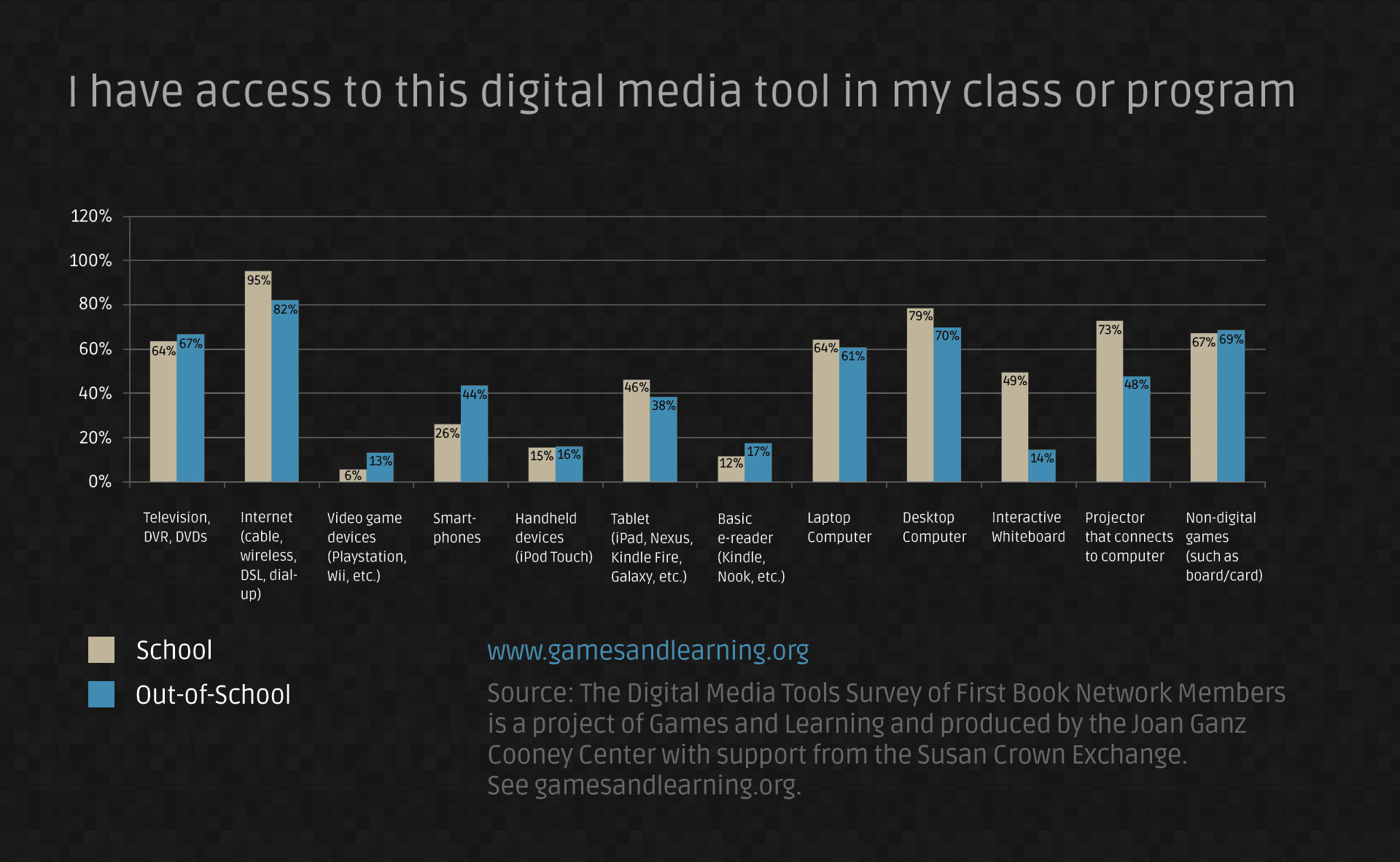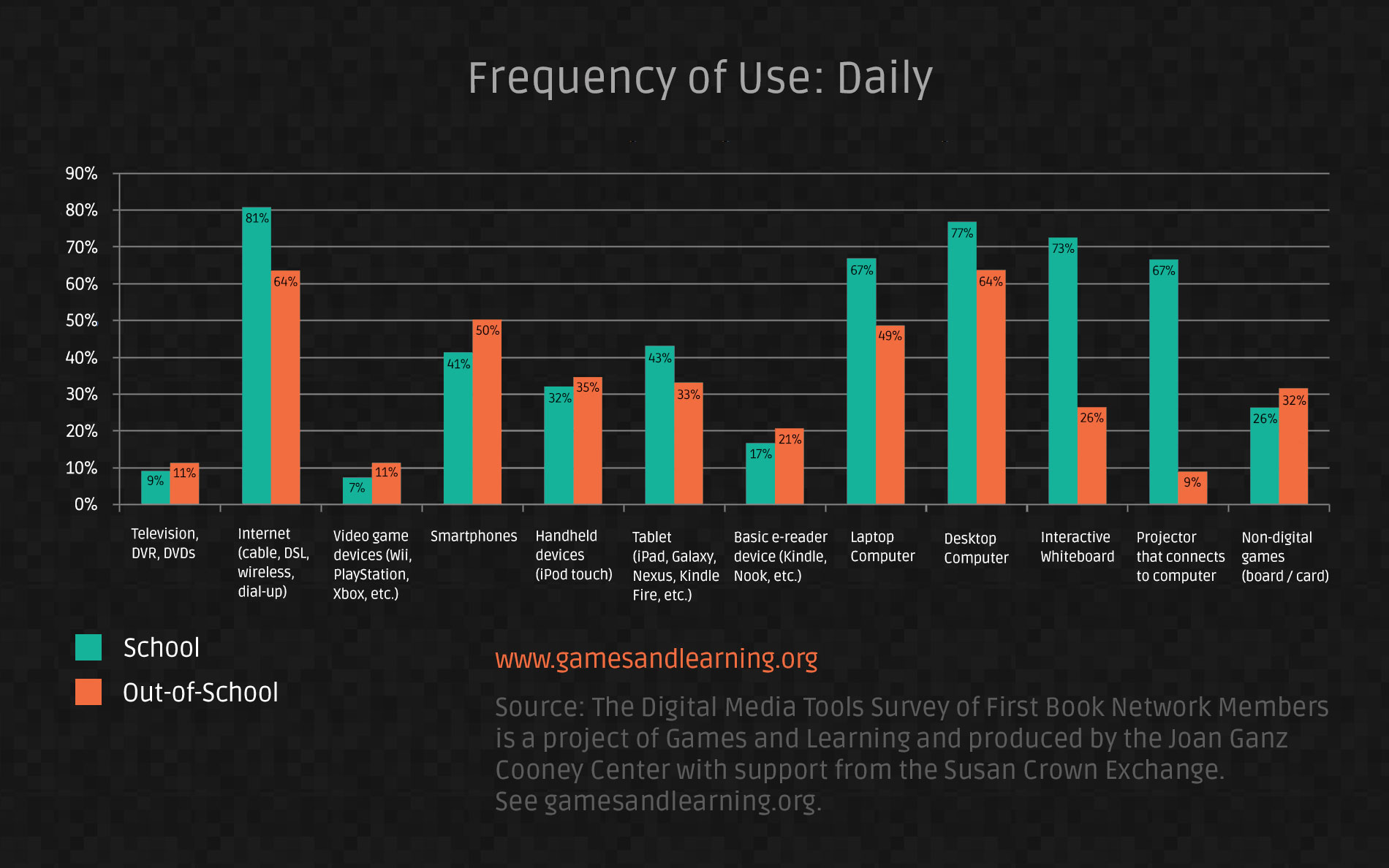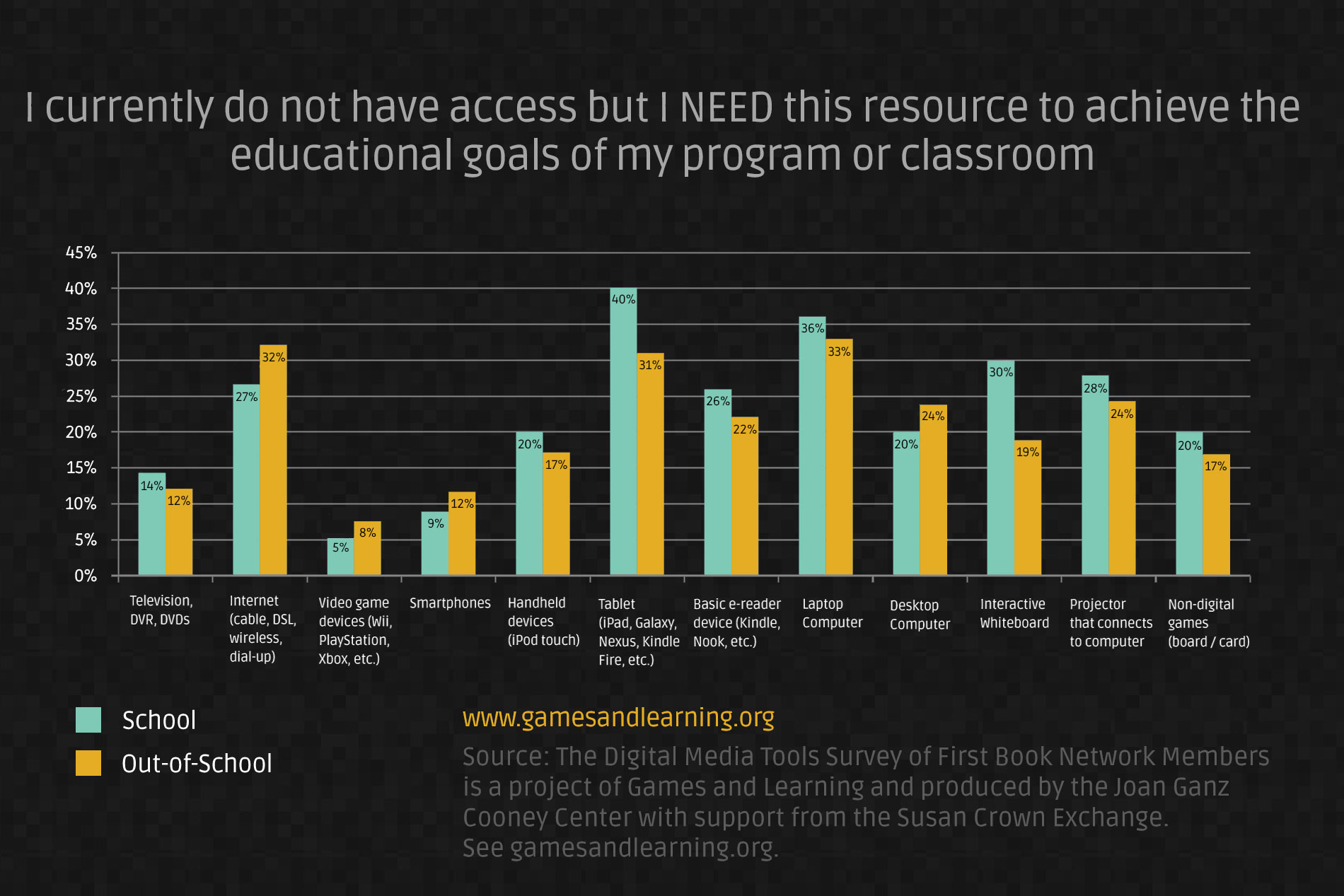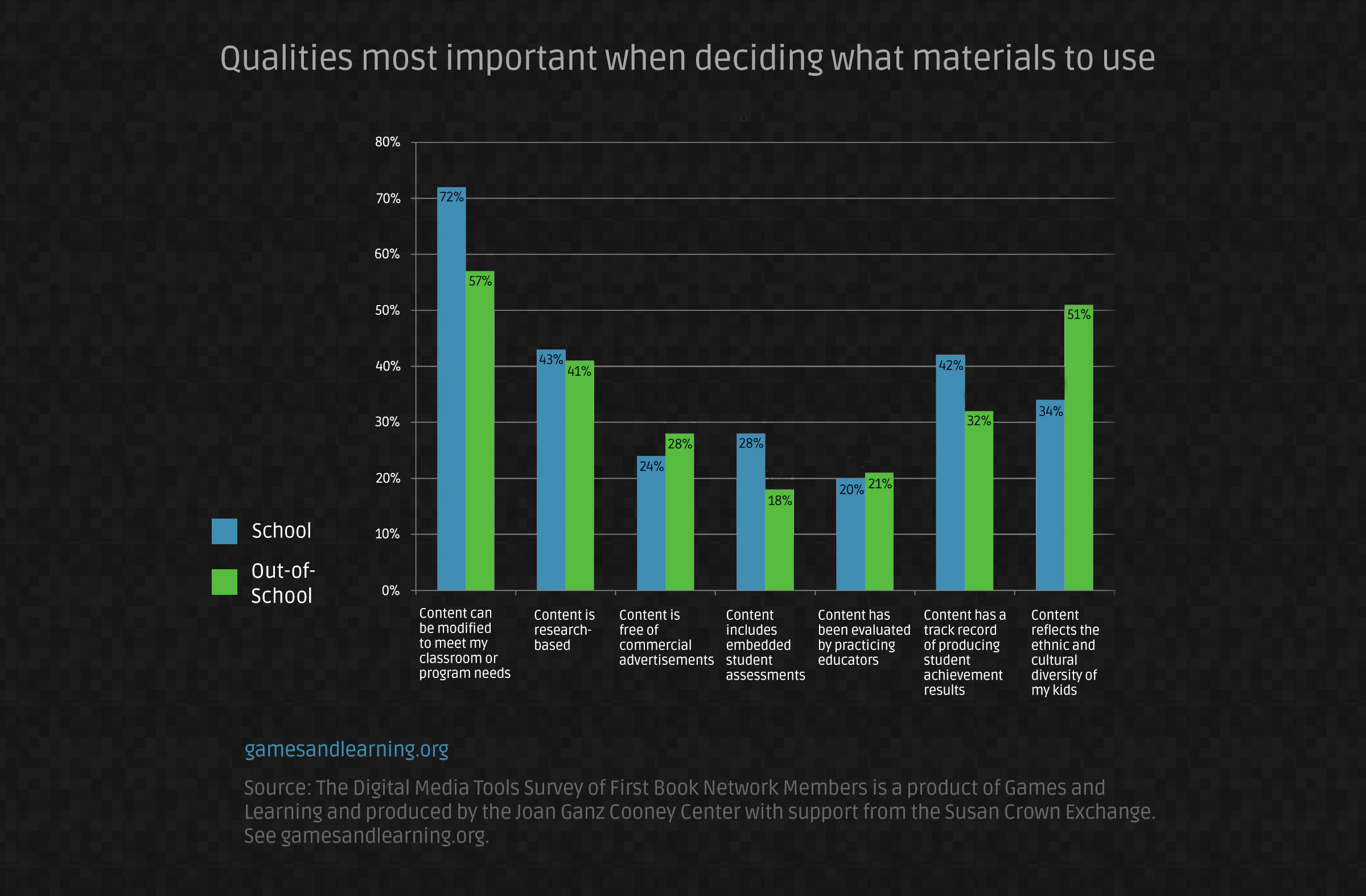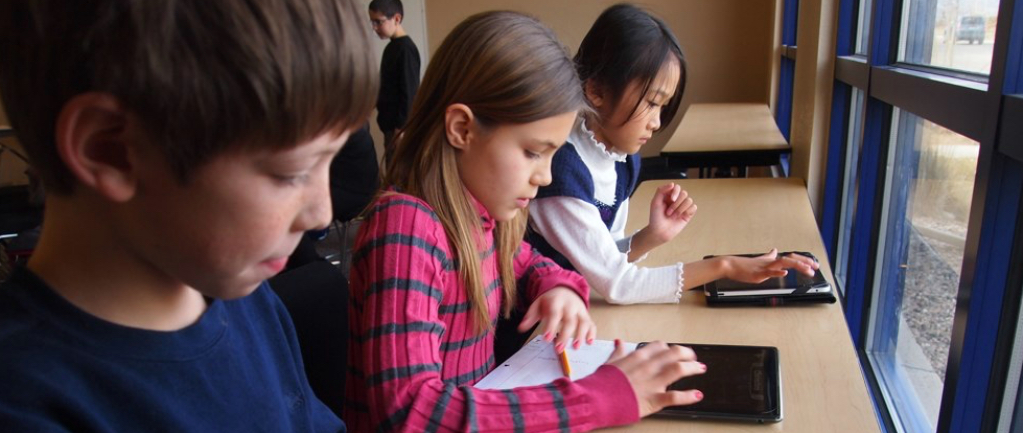
Introduction
Nearly 32 million children are from low-income households in the United States. These kids are often served by schools that receive special Title I funding and after-school and summer programs aimed at giving them as good a shot in life as those from families of means. Research has also said these children, many of whom are at risk of not completing their education or having access to the necessary help to succeed, can be greatly helped by game-based learning and other digital tools.
The Joan Ganz Cooney Center surveyed more than 1,400 people who help these low-income kids. We heard from school teachers and administrators and out-of-school instructors and program directors to get a sense of what kind of technology they have and what kind of tools they need. The survey was of 200,000-person network of First Book, a non-profit literacy organization, and was made possible by the Susan Crown Exchange.
The results are an initial look at a far larger analysis of the state of video and other digital games in the classroom that will be released early next year.
Increasing Access
The responses of more than 1,400 educators and program directors help shed some light on what kind of technologies and tools are currently available to lower-income students. Schools, for the most part, report more access to technology than most out-of-school programs. These established institutions, often bolstered by grants from federal and state governments, have been able to invest in some infrastructure and the results can be seen in this survey. A whopping 95 percent of schools report Internet access (although the speed and reliability of that connection remains varied) and a large majority of schools report access to computers (laptops: 64% and desktops: 79%) and projectors (73%).
Out-of-school program providers still report fairly good access to core technologies like the Internet (82%) and computers (laptops: 61% and desktops: 70%). In a handful of categories, these instructors reported actually having access to more technology like smartphones and e-readers than their formal education partners.
Often these core access issues vary based on where the program or school is located. As one respondent noted, “Internet access can be a challenge due to the rural areas that we serve. Families cant always afford to have access to the Internet and sometimes the reception is just not there.”
What Gets Used?
Access to technology, as any educator or student will tell you, does not equal its use and there were clear gaps between the technology teachers and instructors had access to and what they used regularly. Both school and out-of-school educators said they use videos (52% in school and 58% out-of-school) and the Internet (67% in school and 49% out-of-school) to teach new material to students, although schools seem to rely on digital technologies more for instruction.
Video and other digital games trail far behind these two tools, emerging more as a reward or incentive (52% in school and 47% out-of-school) or as a way to distract kids in between other activities (18% out-of-school). Only in school were games somewhat used to teach new material and then only 20% of teachers said they did it with any regularity.
This is sometimes caused by the difficulty out-of-school instructors and in-class teachers have fully connecting the technology to the class, said many respondents. One comment that was echoed a lot put it this way: “My biggest challenge is to incorporate technology into my everyday program. We have student desktop computers but I would love to provide e-readers to my students. We have not been able to access the vast amounts of e-books due to lack of readers I can lend to my students.”
The story here seems to be that digital games are still seen as a supplement and less a serious teaching platform and this is even more true in after-school and other programs than it is in the formal classroom.
What’s Needed
The shift towards mobile devices, primarily tablets, has clearly taken hold in the school system and to a large degree in the out-of-school programs. Once core technology like Internet connectivity is in hand, teachers and instructors rattle off tablets, e-readers and laptops as the top on the list of equipment they feel like they need to teach these low-income children.
Tablets were the most desired device among school teachers (40%) and the second most selected device by out-of-school program instructors and directors (31%). For both of these groups, laptops were also highly sought after (36% in school and 33% out-of-school).
Interestingly, when asked what they would want to learn more about when it came to being used to teach, both groups selected gaming consoles (47% in school and 34% of after-school programs) as the thing they were most interesting in finding out about. The groups also selected smartphones as another tool (school: 38%, out-of-school: 29%) they wanted to explore more.
One after-school program official noted that much of the technology they feel like they need to do their job remains out of reach, saying, “We are funded solely by donations and grants. Our population of students rarely has any technology at home…..not even computers. We would like to have technology for them but the outlay of funds is significant. We wouldn’t have any technology support either so that could be a problem. We’ve had donations of used laptops but they were so slow and we have no tech person to help us with issues.”
Desired Tools
Despite the challenges these school and non-school instructors and administrators reported there are significant opportunities for digital tool developers among both markets. First of all, the out-of-school market lack the highly structured and often inflexible purchasing systems that can complicate in-school sales. And both formal and informal educators express keen interest in learning more about game-based learning and using mobile technologies to engage students.
One educator noted that they understood the possibilities of digital games and personalized learning, writing, “Schools make a mistake by jumping on the latest research-based curriculum that may only work for the homogeneous population in which it was tested. Kids are gravitating to things like Code Commanders, Minecraft, Dragon Box, LEGO robotics, SimCity, drone technology, self-tutoring programs like Khan Academy & Maker movement activities (Autodesk, MakerBot) — and there is a reason for that and educators should be paying attention to the educational technology that has our kids so captivated and learning as well.”
Both groups cite wanting content and tools that can be easily modified for use in a program or classroom and so longer, linear games are less likely to work for either group. They both also note they look for content that is based in research and, for schools in particular, have a proven track record of helping kids do better.
Of particular note for developers, out-of-school programs as well as many school teachers note that they would prefer content that better reflects the cultural and ethnic diversity of the students they serve, with one saying they had access to only “very limited amounts of good authentic Spanish-language academic resources.”
On Thursday we will report on what the major barriers to the adoption of technology and game-based learning are for both the school and out-of-school environments and what some developers are doing to bring those barriers down through design and deployment.
Methodology
This survey was designed by the Joan Ganz Cooney Center and was fielded during an 11-week period in the Summer of 2015. The survey was sent out to the 185,000 members of the First Book Network. First Book is a non-profit that seeks to help those organizations within school and in the community that serve low-income kids. The network now has 200,000 members. The research was made possible by a grant from the Susan Crown Exchange. Some 1,459 First Book Network members responded and of those filling out the survey 988 worked in formal education and 471 work in out-of-school programs.
Photo Credit
The photo at the top of this page was taken by Brad Flickinger. You can see more of Brad’s photos on his Flickr page.

